Essential Insights on 144 Inch Drapery Rods

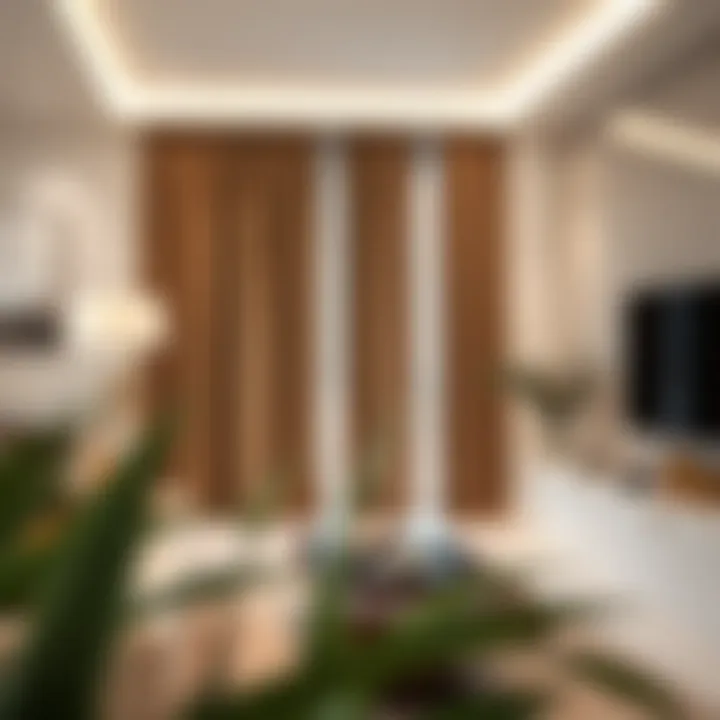
Intro
In the realm of interior design, the right fixtures can make all the difference. One such fixture that often gets overlooked yet plays a pivotal role in the aesthetics and functionality of a room is the drapery rod. While there are many sizes available, the 144-inch drapery rod stands out for its versatility and practicality, making it a popular choice for larger windows or expansive spaces.
This guide explores everything there is to know about this specific drapery rod length. From understanding its various applications and stylistic choices to delving into material options and installation practices, we aim to arm you with all the knowledge necessary to upgrade your living space with finesse.
Making the right selection is critical. Choosing a drapery rod is not just about personal taste; it intertwines with window treatment effectiveness, light control, and an overall aesthetic appeal of the interior decor. Whether you are sprucing up a cozy den, creating a formal dining area, or giving a new touch to your bedroom, the 144-inch drapery rod is indeed an essential component to consider.
Understanding Drapery Rods
The significance of grasping the concept of drapery rods cannot be overstated in the context of home decoration. Drapery rods serve as the essential backbone of window treatments, providing the necessary support for various types of curtains and drapes. By understanding the various aspects, styles, and functionalities of these rods, homeowners and design enthusiasts can make informed decisions that enhance the aesthetic appeal and functionality of their spaces.
Drapery rods are not merely functional items; they contribute significantly to the overall ambiance of a room. They can act as a statement piece or blend seamlessly with the surrounding decor. When selecting drapery rods, aspects like material, color, and design must be considered to align with the interior theme. Moreover, the proper installation and choice of size are imperative for achieving a polished look.
To elaborate further, understanding drapery rods involves recognizing different types available on the market, each serving distinct purposes and catering to unique preferences. As we delve deeper into the nuances of drapery rods, we can appreciate their impact on home decor as well as the flexibility they provide when designing a space.
Definition of Drapery Rods
Drapery rods, essentially, are long, key structural components made to support curtains or drapes that cover windows. They are designed to be mounted horizontally, connecting two walls or extending from a bracket. The materials used in their construction vary widely—from durable metals like steel and aluminum to more traditional options such as wood. Each choice offers its own set of characteristics that influence the overall vibe and appearance.
The Functionality of Drapery Rods
Functionality is one of the primary benefits of drapery rods. They not only offer a means to hang curtains but also work to control light and privacy within a room. Different rod designs can allow for varying curtain styles—from sheer gauzy panels that soften sunlight to heavier blackout drapes for complete darkness. Additionally, they can contribute to energy efficiency by blocking drafts or insulative properties.
Another critical function is the ease of operation. A well-selected drapery rod ensures that the curtains glide smoothly, enabling effortless opening and closing, which enhances user experience.
Different Types of Drapery Rods
Drapery rods come in various types, each designed for particular needs and styles. Understanding these options can make all the difference when setting up your home:
Single vs. Double Rods
Single rods are straightforward with a single pole, making them suitable for standard curtains. On the other hand, double rods allow for layering, permitting a combination of sheer and heavier fabrics on the same window. This versatility brings a dynamic look to a room, adding depth and texture. Single rods often provide an uncluttered aesthetic, which suits minimalist styles beautifully, while double rods can enhance complexity in design, making them popular amongst enthusiasts of layered decor.
Retractable Rods
Retractable rods, often used in spaces where curtains may need to be opened and closed frequently, offer a space-saving solution. The defining feature is their ability to extend and retract, making them ideal for small windows or closets. Their practicality lies in their lightweight design and sleek appearance, but they often lack the ornate style that fixed rods can provide. Thus, while they score high on functionality, they may not always suit traditionally styled rooms.
Tension Rods
Tension rods are unique due to their design, relying purely on friction to stay in place. They work wonders in spaces where drilling into walls isn't an option, such as rental properties. Their flexibility makes them ideal for lightweight curtains or even shower curtains. However, they might not support heavier fabrics, making them less desirable for formal areas or large windows.
Understanding these types lays the groundwork for informing your choices in decor, ensuring both beauty and functionality in the living space.
The Inch Drapery Rod
When talking about drapery rods, the 144-inch option stands out for good reason. The sheer length isn’t just for show; it opens up a world of possibilities for window treatment and partitioning spaces efficiently and stylishly. In homes with larger windows or sliding glass doors, this length provides functionality that shorter rods simply cannot match. Additionally, using a 144-inch drapery rod allows flexibility in design, enabling more elegant draping and layering of fabrics which can add depth and personality to a room.
Moreover, the 144-inch rod serves a multitude of purposes that align perfectly with contemporary living. It’s not merely about function, though. This rod can amplify the aesthetic of your interior, reflecting your personal taste and style.
As you consider the potential applications of such a rod, you’ll realize that its advantages extend well beyond just the basics.
Ideal Uses for Inch Rods
Large Windows
Large windows are often the heart of a home, providing natural light and breathtaking views. Here, the 144-inch drapery rod can frame these openings with grace. Using a longer rod for these sizeable expanses allows for ample fabric, ensuring that when the curtains are drawn open, they gracefully hang to the side without crowding the view.
Key Characteristic: The primary merit of large windows is their ability to invite natural light into space, enhancing mood and ambience. In this context, the 144-inch drapery rod becomes essential to maximize the beauty of the window itself, acting as a stunning frame.
Benefits: Not only do they enhance light, but they also delineate space, making the room feel larger and airier, which many homeowners often strive for.
Sliding Glass Doors
Sliding glass doors often serve as thresholds to outdoor spaces. The 144-inch rod is perfect for these large openings, as it provides the necessary support for heavier draperies without sagging or warping. The ability to smoothly slide the curtains across when needed makes them highly practical.


Key Characteristic: Sliding glass doors are all about connectivity – they connect your indoor environment with the outside world, enriching the area you’re in.
Benefits: With a sturdy drapery rod, you can have an elegant, flowing set of curtains that can be drawn to maintain privacy or opened completely to enjoy the view and light.
Room Dividers
Using a drapery rod as a room divider is an innovative way to implement this longer option. A 144-inch rod can effectively separate spaces in a more temporary and flexible manner. This is especially useful in open-concept homes or studio apartments.
Key Characteristic: Room dividers with drapery provide not only separation but also a sense of warmth and style. They can soften sharp lines in a space, creating more intimate settings.
Benefits: It allows individuals to manage light and sound while still providing the ability to change the layout easily. Customizable fabrics can reflect your vibe, whether modern or bohemian.
Design Considerations
Choosing the Right Material
When selecting a 144-inch drapery rod, material choice can influence both functionality and aesthetic appeal significantly. Options range from wood to metal, each with its own pros and cons. Wood offers warmth and charm, perfect for rustic or traditional spaces. Conversely, metal rods often provide modernity and durability, making them ideal for contemporary settings.
Key Characteristic: Different materials resonate differently with design themes, thus understanding your space’s existing decor can assist in making the right call.
Benefits: Choosing wisely can enhance the overall ambiance of your home. Poor choices may lead to mismatched aesthetics or sub-par performance.
Selecting Aesthetic Styles
A 144-inch drapery rod can be more than just functional—it's a design element in itself. For instance, you might choose elaborate finials or sleek contemporary designs to match the rest of your decor. Each aesthetic style has its significance in how it interacts with other design elements in a room.
Key Characteristic: The rod serves not only as a support for drapery but as a frame of the window, influencing how the light plays within the space.
Benefits: Carefully selecting styles can enhance your home significantly, ensuring each room tells a cohesive story through its design.
Color Coordination
Color coordination when it comes to your drapery rod is often overlooked. The 144-inch rod should complement not just the drapes but the whole room’s palette. Neutral colors work for unmatched versatility, while bold colors can become statement pieces, drawing attention where desired.
Key Characteristic: This adaptability enables easy transitions between seasonal decor, allowing you to change with the times without needing a full overhaul.
Benefits: Knowing how to coordinate colors can promote harmony in your home, ensuring that every component works together beautifully.
"The right drapery rod is akin to the right frame for a painting; it can elevate the beauty that lies within." - Unknown
Crafting an effective and visually pleasing environment begins with considering the elements mentioned above. A 144-inch drapery rod is more than just a practical object; it's a versatile tool that can transform spaces, bringing elegance and style to your living areas.
Material Choices for Drapery Rods
Choosing the right material for drapery rods is crucial. It affects not just the rod's appearance but also its durability and function. Each material has its unique qualities and brings a different vibe to a space. The three primary options available—wood, metal, and vinyl/plastic—offer varying aesthetics and practical benefits that should be carefully considered.
Wooden Rods
Advantages of Wood
Wooden drapery rods present an elegant and timeless appeal. They're often chosen for their natural beauty and warmth, which can add a cozy touch to any room. The key characteristic that makes wood a popular choice is its solid structure, enabling it to bear heavier curtains without sagging. Additionally, wooden rods can be easily customized through painting or staining, aligning perfectly with any decor style. However, they do require regular maintenance to prevent warping or cracking, especially in humid environments.
Best Decorative Styles
When it comes to decorative styles, wooden rods shine in versatility. They can complement a rustic theme with distressed finishes or enhance elegance with polished, dark finishes. Highlighting their unique feature, wooden rods can be found in ornate designs, often featuring finials or intricate carvings, which make them an appealing focal point. Despite their large array of styles, the main disadvantage lies in their weight; they might not be suitable for every situation, especially in high-traffic areas where durability is a must.
Metal Rods
Durability and Versatility
Metal drapery rods are celebrated for their durability and versatility. Crafted from materials like steel or aluminum, they can support heavy drapes without bending. The key attribute of metal rods is their ability to fit into a variety of design schemes—from industrial chic to modern minimalism. They are generally resistant to corrosion, which adds to their longevity. However, they might not provide the same warm feeling that wood does.
Finish Options
One of the most appealing aspects of metal rods is the range of finish options available. Whether you prefer a sleek chrome, a rustic bronze, or a matte black, there is a finish to match every decor style. Unique to this material, metallic rods can also have textured surfaces or embellishments that showcase personal style. Although they offer many aesthetic draws, some may find them less inviting than their wooden counterparts, possibly making the space feel colder.
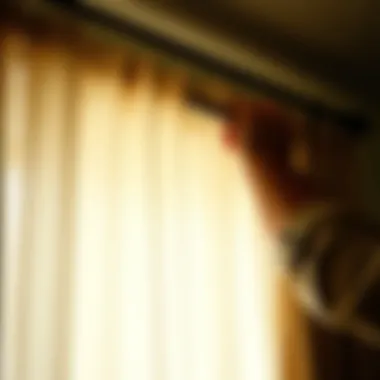
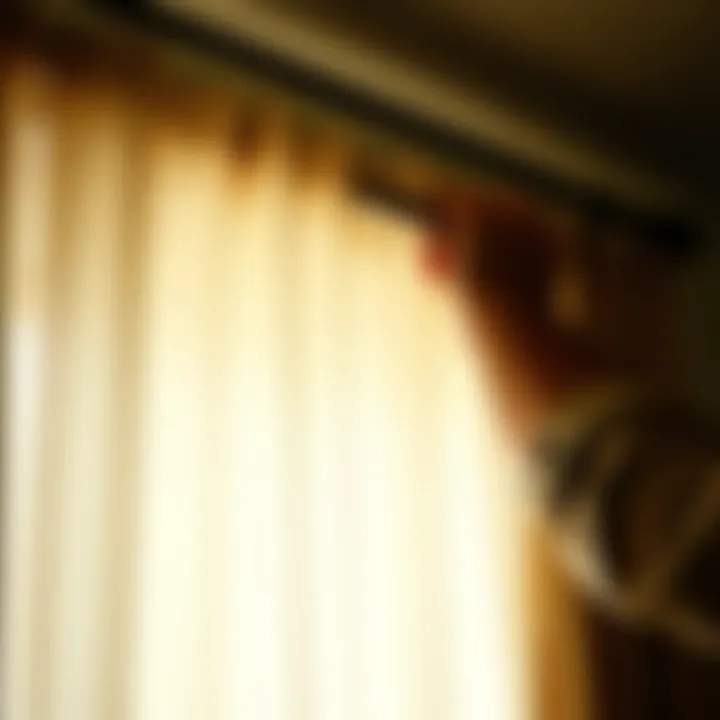
Vinyl and Plastic Options
Cost-Effectiveness
When it comes to budget-friendly choices, vinyl and plastic rods stand out due to their cost-effectiveness. They are significantly cheaper than wood or metal, making them a popular choice for those just starting with home decor or for temporary setups. The unique aspect of plastic rods is their lightweight nature, allowing for easy handling during installation. However, this lightweight advantage can come with a trade-off: they might not be as sturdy and could warp under heat or with heavy fabric.
Aesthetic Limitations
On the flip side, there are some aesthetic limitations to consider with vinyl and plastic. They often lack the refined look of wood or metal alternatives and can lead to a more casual or utilitarian feel in a space. While they come in a variety of colors and certain decorative styles, their overall quality and visual appeal might not satisfy more discerning tastes. Plastic rods can become an eyesore when not in sync with a sophisticated design ethos.
In summary, selecting the right material for drapery rods plays a pivotal role in both the practical and aesthetic aspects of home decor. Each option brings its unique strengths and weaknesses, making it essential to consider personal style, functionality, and budget.
Installation of a Inch Drapery Rod
Installing a drapery rod is not just about mounting it on a wall; it’s an integral part of home decor that can set the tone of your room. The correct installation of a 144-inch drapery rod hinges on specifics—that’s where the beauty lies. A well-installed rod ensures smooth function and enhances the aesthetic appeal of your space. Incorrrect alignment or support might lead not only to an uneven look but to potential damage over time.
Necessary Tools and Materials
Before you take the plunge into installation, you need to gather your tools and materials. Having everything within reach makes the process much smoother, avoiding the frustration of hunting for items mid-project. Here’s what you should have:
- Drill – A key player in securely mounting your rod.
- Screwdriver – For securing brackets.
- Level – This one’s important to keep things straight—nobody likes a crooked rod.
- Measuring tape – Precision makes all the difference.
- Pencil – To mark where everything goes.
- Mounting brackets – Usually included with your drapery rod.
By having all your tools ready, you eliminate the chances of making missteps during installation.
Step-by-Step Installation Process
Getting your 144-inch drapery rod installed doesn’t have to be a daunting task. Follow these steps for a seamless approach.
Measuring the Window
Measuring the window correctly is the backbone of a successful installation. This feels like a no-brainer, but it’s critical to take your time. An accurate measure ensures that the rod fits perfectly across your window frame. When you measure, consider whether you want the rod to extend past the window. This is a common choice to create an illusion of larger windows. Remember, measure twice, cut once.
Marking Drill Points
Once you’ve measured and are confident in your dimensions, marking the drill points takes precedence. Using a level at this stage is essential; it helps guarantee that your markings are even. Here’s a tip: make your marks slightly above where you want the brackets to be. This prevents the rod from appearing too low and allows the fabric to hang beautifully.
Securing Brackets and Rod
With everything marked, it’s time to secure the brackets and the rod. Start by drilling holes at your marked points, then fix the brackets tightly, ensuring they are level. After this, gently slide the rod into place. It should feel sturdy, and the drapery should glide with ease. This step is not just about aesthetics but about functionality as well.
Tips for Successful Installation
Success in installation often hinges on a few practical tips that can make your life a lot easier.
Ensuring Level Alignment
Ensuring level alignment can’t be overstated. Picture it: one end of your rod is higher than the other—definitely not a good look. Using a level during the installation process not only allows you to check your work as you go, but it also saves you time and headaches later on. Plus, a well-aligned rod enhances the overall flow of your curtains.
Adjusting for Uneven Walls
Walls aren’t always perfect; it’s a fact of life. If your walls are uneven, you’ll need to adjust accordingly. This might mean using shims or brackets that accommodate odd angles or bumps in the wall. By addressing these issues upfront, you save yourself future frustration. A little adjustment today can lead to a beautifully hung drapery tomorrow.
Remember, patience is key! Taking the time to measure, mark, and align properly is worth it to achieve that polished look for your home.
Maintenance and Care Tips
Maintaining your drapery rod is paramount for ensuring it remains not only functional but also aesthetically pleasing. Just like regular upkeep on the roof keeps water from ruining your interior, taking care of your drapery rod preserves your home’s charm. By following some simple maintenance and care tips, you can enhance the life of your drapery rod while ensuring it continues to perform effectively.
Cleaning Your Drapery Rod
Regular cleaning of your drapery rod helps to eliminate dust and debris, which can accumulate over time. Not only does regular cleaning keep your drapery rod looking sharp, but it also prevents dirt buildup that could affect the rod's functionality.
Material-Specific Cleaning Techniques
Different materials require different cleaning approaches. Wooden rods, for instance, benefit from a gentle approach using a soft, damp cloth. Too much moisture can warp the wood, so a light touch and being careful is crucial. Metal rods, on the other hand, tend to require just a quick dusting and the occasional polish with a metal cleaner, depending on the finish. Vinyl and plastic rods are often best cleaned with warm soapy water, which is a straightforward method. These adaptations are smart choices because they cater to the individuality of each material, ensuring that your rod remains in tip-top shape over the years.
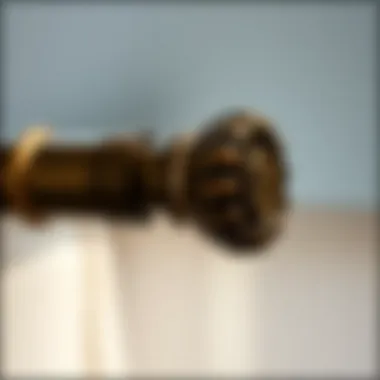
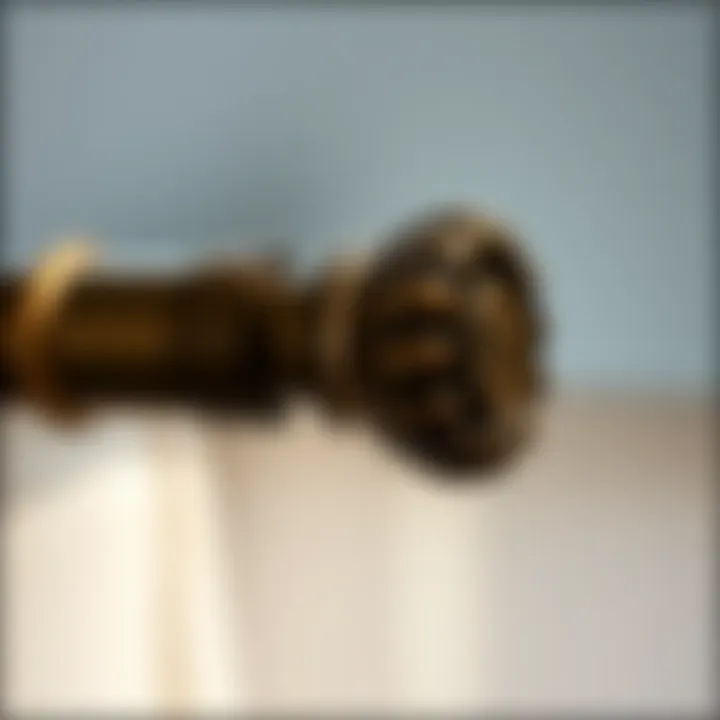
Regular Maintenance Routines
Having a regular maintenance routine for your drapery rod is beneficial. Aim to inspect and clean your rods at least once every three months. This approach allows you to stay ahead of any potential issues that may arise. Dusting or wiping down surfaces can be a quick task that mitigates larger problems down the line. It is also a good chance to check for any signs of wear and tear. Establishing this habit is key; think of it as a seasonal inspection for your home decor, ensuring everything is safe and sound while enhancing the overall appearance of your space.
Checking Stability and Security
A stable drapery rod is fundamental for both the functionality and safety of your window treatment. This section outlines crucial checks you should perform to ensure your drapery rod remains secure.
Identifying Loose Fixtures
Keeping an eye out for loose fixtures is vital to ensure the longevity and safety of your drapery rod. Over time, the weight of the drapes or external vibrations can cause brackets or screws to loosen. Regularly inspecting these fixtures can save you from a sudden mishap, such as the rod coming down when least expected. Notably, ensuring that all fixtures are tightened and securely fastened helps maintain a perfect alignment, which is aesthetically appealing as well. This attention to detail promotes both safety and beauty in your living space.
Reinforcement Methods
When it comes to reinforcement, various methods can bolster the security of your drapery rod. One popular option is to use wall anchors for added stability. This method spreads the weight distribution, especially on drywall, preventing any slippage. For heavier curtains, consider employing additional brackets to provide support in the center. These strategies are profitable for implementing an enduring fixture that withstands the test of time, ensuring your drapery rod remains functional while looking polished in your home.
Regular maintenance and timely inspections of your drapery rod can greatly enhance its longevity and functionality. Neglecting these simple tasks can lead to inconvenient problems down the road.
Enhancing Aesthetic Value
When it comes to interior decor, the aesthetic value of a space cannot be overstated. Drapery rods, particularly the 144-inch variety, significantly contribute to the overall look of a room. They serve not just as a functional element but also as a design feature that can transform a bare space into an inviting sanctuary. Choosing the right drapery rod can enhance the visual appeal, adding an element of sophistication or warmth, depending on the style adopted.
Innovative Drapery Styles
Layering Curtains for Depth
Layering curtains is a veritable game changer in creating textured visual appeal. This technique involves using multiple curtain layers to infuse depth into the window area, giving a three-dimensional character to otherwise flat surfaces. By mixing sheer fabrics with opaque drapes, homeowners can control light levels while enhancing privacy. This method adds a luxurious feel and is highly favored among decorators.
The unique feature of layering is its flexibility. You can switch layers according to seasons or moods, keeping the decor dynamic. However, one should exercise caution with heavy fabrics, as they might overwhelm the space if not balanced well. Overall, layering curtains is a popular choice in interior design due to its potential for personalization and striking appearance.
Using Tiebacks and Holdbacks
In the realm of drapery, tiebacks and holdbacks play a pivotal role in how curtains diffuse light while accentuating style. These accessories are used to draw curtains away from windows, creating an open and airy ambiance. They come in various designs and materials, allowing them to complement or contrast with the curtains themselves.
A defining characteristic of tiebacks and holdbacks is their ability to break the monotony of flat curtains. They also serve a practical purpose, keeping drapes neatly aside when fully opened. One downside is that they can require additional effort during installation and may not suit all curtain types. Despite this, their appeal and functionality make them a favorite choice for adding flair to drapery.
Integrating with Interior Design
Matching with Furniture
Harmonizing drapery rods and curtains with furniture is essential in achieving a cohesive look within a room. The right match can tie together various elements of the interior, making the space feel designed rather than assembled. Attention to fabric patterns, textures, and colors can create visual continuity that enhances both drapes and furniture.
One effective aspect is considering the material and finish of furniture alongside the drapery rod. For instance, a rustic wooden rod paired with organic fabric curtains can create an inviting atmosphere. Conversely, sleek metal rods work wonderfully with modern furniture lines. The only pitfall is becoming overly fussy with patterns that compete for attention. A well-chosen drapery style can elevate the entire room's essence.
Creating a Cohesive Color Palette
Establishing a cohesive color palette is essential for any decor project, including drapery selection. By choosing curtain colors that reflect the overall color scheme of a space, one can create a harmonious relationship between different design elements. This technique can tie in various components, such as walls, furnishings, and decorative accessories.
A vital feature of a cohesive color palette is how it can evoke specific moods. For instance, soft blues and greens can create a calming environment, while warm reds and yellows can energize a space. Choosing complementary colors can make the area feel more expansive and inviting. However, there is a risk of overloading the space with too many colors, which can create confusion rather than cohesion. Tailoring the selection of colors allows for a balanced and aesthetic experience.
Epilogue
When it comes to home decor, the subtleties often make the most significant impact. This article aimed to bring the spotlight to the 144-inch drapery rod, showcasing its multifaceted role in enhancing both aesthetics and functionality within your living spaces. The takeaway is clear: selecting the right drapery rod is not just a matter of practicality, but it’s also about creating a harmonious look in your home.
Recap of Key Points
- Versatility in Use: The 144-inch drapery rod is ideal for larger windows, sliding glass doors, and even as an elegant room divider. This size allows for plenty of fabric, making it possible to achieve sweeping, luxurious looks.
- Material Matters: Different materials—like wood and metal—have unique benefits. Wooden rods often lend warmth and character, while metal options promise durability. Understanding the pros and cons of each is crucial for making a wise choice.
- Installation Insights: A successful installation hinges on having the right tools and understanding the step-by-step process. Whether you tackle it yourself or hire a professional, ensuring everything is level and secure is paramount.
- Maintenance for Longevity: Regular cleaning and checks on stability can significantly extend the life of your drapery rod. Keeping on top of maintenance means less hassle down the line.
- Aesthetic Value: Choosing drapery that complements your existing decor style—be it modern, traditional, or anything in between—can elevate your interior. Layering styles and incorporating tiebacks are just a few ways to add complexity and depth.
Final Thoughts on Drapery Selection
Selecting a drapery rod should be approached with both function and form in mind. Ask yourself what kind of ambiance you wish to create. Is it a cozy, relaxed vibe, or are you aiming for a sleek, modern aesthetic? The 144-inch rod can cater to either style, depending on your fabric choice and installation techniques.
Also, keep in mind the importance of proportion and balance. The rod should not only fit your window appropriately but also consider the scale of the room. A larger rod may visually anchor the space if you have high ceilings or expansive windows, while a more delicate rod may suit smaller environments.
Drapery selection is more than just picking something out at random; it’s about crafting an experience in your living space. Remember that all these details culminate in a unified whole, enhancing your home’s charm and functionality.
As you ponder your next home styling project, let the insights from this guide guide the way. Each choice you make regarding your drapery rods could knit together the overall tapestry of your home atmosphere, helping create a welcoming and stylish retreat.
"The best designs are those that integrate seamlessly into the life being lived within the space."
For more on this topic, consider exploring additional resources like Wikipedia, Britannica, or join discussions on platforms such as Reddit about people’s experiences and preference.



